“War is such an unjust and evil thing that those who wage it try to stifle the voice of conscience within them.”1
“Art should cause violence to cease.”2
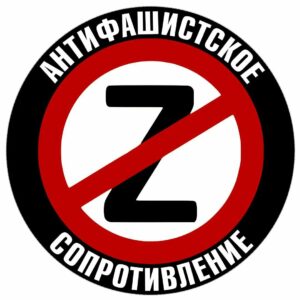
“Anti-Fascist Resistance” logo, targeting the “Z” symbol of the Russian military
Count Lev Nikolaevich Tolstoy (1828-1910) was a globally renowned White-Russian prose poet, journalist, ethicist, and Christian-anarchist critic. Though he fought as a cadet in the Eastern Caucasus and became an artillery officer in the Imperial Russian army as a young man, he would resign as a first lieutenant in 1856, after two years.3 Rather than affirm Tsarist colonialism or jingoist pan-Slavist ideologies, as did the celebrated novelist Fëdor Dostoevsky (1821-1881), Lev Nikolaevich from the start of his writing career expressed critical views of imperial violence and dispossession. This can be gleaned from “The Raid” (1853), the “Sevastopol Sketches” (1855), The Cossacks (1863), and War and Peace (1869). In its dual rejection of the exaltation of violence and the worship of power, the writer’s humanist war correspondence is motivated by the utopian hope that lending a voice to those who suffer the most in armed conflict might “drastically reduce its incidence” in the future.4
Written as eyewitness accounts of the siege of the Russian naval base by British, French, and Turkish forces during the Crimean War (1853-1856), the “Sevastopol Sketches” portray such scenes of devastation that “shake [one] to the roots of [one’s] being.”5 As such, Count Tolstoy’s purpose in these reports runs parallel to Siddhartha Gautama Buddha’s teaching from two and a half millennia ago: that awakening begins through acknowledgment of the traumatic reality.6 Establishing himself in these “Sketches” as a “seer of the flesh,” both living and dead, who interweaves poetry and truth, Tolstoy contests those liberal and radical thinkers who focus on the “achievements and ferocious power of the state” while ignoring the “horrific consequences of this power for millions.”7 He repudiates the “galactic” view of existence that would regard Earth from above, and see humanity as a tool to manipulate, manage, and destroy.8 The artist parts company with those who would portray combat as romantic by communicating the straightforward ideas that militarism is based on male sadism and vanity, and that war constitutes murder and ultraviolence.9
No surprise, then, that Tolstoy remains excommunicated within Vladimir Putin’s Russia. Indeed, just last month, the megalomaniacal Russian president ordered a full-scale invasion of Ukraine. Employing projection and pretext, Putin announced a “special military operation” to “demilitarize and de-Nazify” the country. In reality, this former KGB spy and director of the post-Soviet FSB, embittered by the collapse of the Soviet Union, is overseeing a genocidal assault on the Ukrainian people. Brutal violence has long been Putin’s favored approach: the security analyst Anna Borshchevskaya discusses the possibility that he ordered the FSB to bomb apartment buildings in three Russian cities in September 1999. Whether or not he was responsible, Putin blamed these acts of terror on Chechen rebels, while exploiting them both to launch a Second Chechen War (1999-2009) and to secure the presidency in 2000.10 Since then, the Russian despot has led “anti-humanitarian interventions” in Georgia, Syria, Kazakhstan, and Ukraine. Now, nearly a month into his ill-fated foray into Ukraine, the Russian leader mimics his ally Donald Trump by hosting a self-congratulatory fascist rally.
In this essay, we will examine Tolstoy’s “Sevastopol Sketches,” emphasizing its tragic realism, anti-militarism, and anti-authoritarianism. Afterward, in the spirit of the Russian artist, we will meditate on parallel war crimes that have been carried out in Syria over the past decade-plus by forces loyal to Putin and Bashar al-Assad. In this sense, we agree with free Syrians and Human Rights Watch director Kenneth Roth, who alike see in Russia’s 2015 military intervention in Syria a clear precedent for the current offensive against Ukraine. Ominously, a spokesperson for the Russian Ministry of Defense has likened the Ukrainian resistance to “international terrorists in Syria.” So far, it is clear that the Russian military is using the same atrocious tactics in Ukraine as in Syria, including the direct targeting of hospitals, journalists, bakeries, and residential areas.11 While millions of Ukrainians flee the country or shelter in basements, just as Syrians do and did, the Assad regime is recruiting thousands of mercenaries to fight in Ukraine, now that Russia’s initial blitzkrieg has failed.
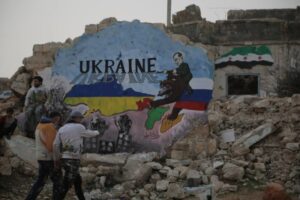
Mural for Ukraine painted by Aziz Al-Asmar in Idlib, Syria, February 2022 (Middle East Eye/Bilal al-Hammoud)
The Sevastopol Sketches
Lev Nikolaevich Tolstoy’s “Sevastopol Sketches” are comprised of three short first-hand reports on the besiegement and fall of the main Russian-occupied port city of Sevastopol during the Crimean War, between October 1854 and September 1855. These “Sketches” constitute unsettlingly realistic dispatches from the front lines that might have their equivalent today in emergency news reports from Syria, Palestine, Yemen, Ethiopia, Afghanistan, or Ukraine which depict suffering with compassion, demanding immediate remedial action.12 Written as “anti-war” correspondence, the “Sketches” are the product of Tolstoy’s commission as an artillery officer in 1854, and of his experiences in the embattled port-city following his transfer there as a second lieutenant the following year.13 Regardless of his humanistic bent, though, Tolstoy erases the important role played by Muslim Crimean Tatars in the city’s defense, in keeping with his silence over their colonial dispossession, which began with Tsarina Catherine II’s annexation of Crimea in 1783.14 At present, Crimean Tatars are courageously taking up arms against Putin’s “special military operation.”
Published in the literary journal The Contemporary that had been co-founded by Alexander Pushkin (1799-1837), Russia’s national poet, the same “Sketches” which ironically brought the young Tolstoy celebrity were the product of his autonomous mental labor, following the moribund Tsar Nicholas I’s denial of the lieutenant’s proposal to launch a weekly forces newspaper.15 Significantly, the writer employs narrative realism in the “Sevastopol Sketches” not to mystify or endorse inter-state violence, but rather to defamiliarize or ‘estrange’ the suffering and exploitation demanded by war and militarism before his audience, who accordingly become spectators once-removed from the scene of desolation. In the “Sketches” and subsequently in The Cossacks and War and Peace, the artist at once defamiliarizes, reviles, and deprovincializes warmongering and statist ideologies. He does so by repudiating the resigned acceptance of such destructiveness while providing “intimacy at a distance.” In this way, he seeks to restore the humanity of war’s victims, and to encourage cosmopolitan-internationalist sensibilities in his readers.16
In 1853, Nicholas I declared war on the Ottoman Empire, seeking to take control of its European territories in the Balkans and “liberate” its Orthodox Christian subjects. In response, the British and French allied with the Turks to invade the Crimean Peninsula and assault Sevastopol. Their aim was to capture the Russian naval base, the principal port for the Tsar’s Black Sea fleet, toward the end of neutralizing regional Russian expansionism.17 Subjected, then, to a merciless assault by the French and their allies, the soldiers, sailors, and civilian populace of the port-city experience “a total absence of the human and of any prospect of salvation.” Tolstoy observes that, in Sevastopol, “everywhere [one] perceive[s] the unpleasant signs of a military encampment.” Like Virgil in Dante’s Inferno (1320), the writer takes his readers on a tour of a world comprised of the fortress and its eight bastions. The story begins in December 1854 in the Assembly of Nobles, which has been transformed into a makeshift field hospital.18
Showing compassion for the war-wounded in this effective slaughterhouse, the onlooking narrator demonstrates Tolstoy’s commitment to the politics of pity, defined by scholar Lilie Chouliaraki as the “symbolic mechanism[s…] by means of which various media […] construe the spectator-sufferer relationship via emotions of empathy and enunciation or aesthetic contemplation.” Centering the agora—or the realm of reflection and argument—and the theater—or the realm of fellow-feeling, identification, and agency—in these “Sketches,” Lev Nikolaevich Tolstoy seeks to convince readers not only of the immorality of warfare, but also of the urgent need to overcome their status as voyeuristic spectators who may just be “sit[ting] back and enjoy[ing] the high-adrenaline spectacle.” Implicitly, he enjoins audiences to channel their emotional reactions into protesting against militarism and social hierarchy.19
Approaching a young wounded warrior, Tolstoy’s guide asks him about his injuries. In response, the youth betrays the self-surrender expected of a soldier (or worker): that “[t]he main thing […] is not to spend too much time thinking about it.” The narrator witnesses a sailor whose chest is “blown away” by a mortar contritely apologizing to his comrades as he perishes. Likewise, surgeons “with pale, gloomy physiognomies” are shown operating effective (dis)assembly lines to amputate the limbs of injured soldiers. One of these surgeons, performing triage, records over five-hundred thirty admissions to the field hospital in a single day in May 1855.20 Besides physicians, 163 Russian female nurses, supervised by the proto-feminist surgeon Nikolai Pirogov (1810-1881), served in front-line field hospitals in Crimea, where they courageously attended to the injured and dying while exposed to artillery barrages and typhus.21 From the other side of the line of control, British nurse Florence Nightingale’s (1820-1910) statistical findings on the causes of death in Allied hospitals showed that “far more men died of disease, infection, and exposure than in battle.”22
Overwhelmed by agony, the factitious Russian Prince Galtsin cannot stand more than a moment in Tolstoy’s bleak Assembly Hall. Seemingly everywhere, intermixed with the mire, can be found “shell splinters, unexploded bombs, cannonballs and camp remains,” and one is assaulted by a ceaseless hail of bullets and shells. For this reason, war is depicted not as “a beautiful, orderly and gleaming foundation,” as the authorities would prefer, but rather, according to the politics of pity, “in its authentic expression—as blood, suffering, and death.”23
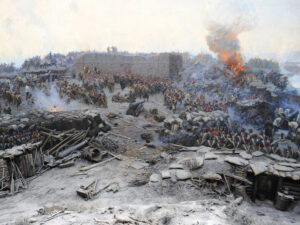
Franz A. Rombaud, detail of Sevastopol Panorama (1904)
Estimates suggest that the casualties incurred during the final attack on Sevastopol reached twenty-four thousand on both sides, or about one-tenth of the total from all causes over the course of the siege.24 In contemplating the mass-casualties experienced during this time, Tolstoy’s narrator wonders whether it would not have been more just for two representatives of the warring sides to have dueled, and the conflict’s outcome to have been based on that result. For war as it is practiced is “madness.”25 Through these “quixotic musings” about duels as an alternative to full-blown wars, Tolstoy “dispute[s] the rationality and morality of violence in general.” He does so by implicitly disavowing his landowning class and identifying with anti-militarist values expressed by Russian peasants. In reality, many muzhiki (male peasants) believed that World War I should have been resolved through a village brawl, rather than through mass-slaughter.26 These peasants had an important point: the suffering and death of even one soldier in war “symbolizes [the] ‘universal’ human state of existence” of objectification and brutalization. In other words, to humanize the victims of war, we must treat every casualty as a person.27
In Tolstoy’s Sevastopol, Prince Galtsin and the Polish Lieutenant Nieprzysiecki harass wounded soldiers for retreating, whereas the enthusiastic, newly arrived volunteer Lieutenant Kozeltsov, anticipating “the laurels of immoral glory,” confronts demoralization and horror upon learning the reality of the situation. Alongside soldiers, civilians suffer, too. A sailor’s widow and her ten-year old daughter remark on the sight of a French artillery barrage at night. The girl cries, “Look at the stars, the stars are falling!” while her mother laments the impending destruction of their home, cursing the “devil” for “blazing away” and bringing “horrible things.” The adjutant Kalugin adds that “sometimes [it’s] impossible to tell which are shells and which are stars!”28
Tolstoy further defamiliarizes the scene by focusing on the responses of a ten-year old boy to all this devastation, contrasting his instinctual horror, based on natural goodness (in accordance with Jean-Jacques Rousseau’s ideas), against the statist-militarist normalization of such destructiveness. The scholar Liza Knapp hypothesizes that
Tolstoyan pacifism has its seeds here, where Tolstoy makes the boy, and the reader, pay attention to the corpses, to the sight, smell, and feel of them, and where Tolstoy points to the basic contradiction between the brotherly love that the soldiers at Sevastopol profess […] and the killing that they practice.29
Echoing this point, officer Kalugin thinks to himself that he should amount to something more than the “cannon fodder” to which soldiers are reduced in combat. In this moment, he anticipates how Prince Andrei Bolkonsky similarly laments the reduction of young men to pawns in War and Peace.30 At the end of his account from May 1855, Tolstoy juxtaposes the dystopian sight of hundreds of corpses, or “the bodies of men who two hours earlier had been filled with all manner of hopes and desires,” and the thousands injured between the Allied and Russian positions with the beauty of the stars, the “thundering” sea, and the “mighty, resplendent” sun, as though to decry the betrayal and denial of “joy, love and happiness” owing to war. After all, such tense dynamics are not limited to the nineteenth century. As we know from history and the present, when talks among states fail, “cannons start firing, and people, with all their aspirations and potential, begin to die in droves.”31
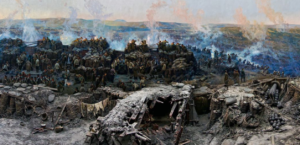
Franz A. Rombaud, detail of Sevastopol Panorama (1904)
Anti-War Meditations, from Crimea to Syria, Ukraine, and Palestine
Tolstoy’s disturbing albeit realistic presentation of the horrors of warfare in the “Sevastopol Sketches” certainly has its echoes today. Though the “Sketches” were published more than a century and a half ago, the problems of war, imperialism, dehumanization, and ultraviolence continue in our own day, considering that the State and capitalism persist as the dominant global forms of social organization—as in the nineteenth century. At the same time, whereas the “Sketches” illustrate an inter-imperialist conflict involving the British, French, Ottoman, and Russian Empires, Putin’s ongoing assault on Ukraine threatens an independent nation with reconquest by the former imperial power. Seen from an Enlightenment rationalist perspective, the Crimean War, the Syrian counter-revolution, and the Russo-Ukrainian War are senseless, ruthless, and reactionary. They speak to our predicament of being “stuck” within ossified relations of domination. It is indeed telling that so many Russian soldiers who have surrendered to the Ukrainian military since the offensive began should say they don’t know why they had been obeying orders in this fratricidal conflict. Likewise, one of Tolstoy’s alter egos, Prince Andrei, admits in War and Peace not to know why he is fighting, either.32
Furthermore, the gloomy surgeons amputating Russian soldiers en masse in Sevastopol eerily bring to mind the thousands of Palestinian protesters, mostly youth, whom the Israeli military injured and killed during the “Great Return March” demonstrations that began in March 2018. As of late 2019, at least six hundred of these protesters who were shot in the legs had developed osteomyelitis, a bone infection that can threaten the viability of limbs. Over three hundred such protesters have died in Gaza. It is also striking to consider how closely the comments of the sailor’s widow and her ten-year old daughter in the “Sketches” echo the desperate realities confronted by millions of courageous Syrians who have risen up against Bashar al-Assad’s fascist regime—only for this regime and its Russian and Iranian backers to have murdered hundreds of thousands, and possibly over a million, of people in response.
If Terry Eagleton is right that “[t]he traumatic truth of human history is a mutilated body,” and if John P. Clark is right that meditation on a corpse is “one of the most ancient and most useful meditative practices,” then perhaps meditation on the vast war casualties from the Syrian counter-revolution can be similarly useful, according to a tragic-humanist framework, toward the end of alleviating future episodes of suffering and exclusion—as the Ukraine invasion has starkly shown.33
As the members of The Lancet-American University of Beirut Commission on Syria note, “[t]he conflict in Syria has caused one of the largest humanitarian crises since World War 2.”34 In reality, in a 2021 report, the UN Commission of Inquiry found evidence of “the most heinous of violations of international humanitarian and human rights law perpetrated against the civilian population” in the country, including genocide. Plus, in an unprecedented March 2021 report on violations of international law perpetrated by the Russian military since its September 2015 intervention in Syria, Russian human-rights groups lament how State-controlled media have blocked out the vast human costs of the war—just as Putin has now prohibited that the war on Ukraine be described as anything other than a “special military operation.” To contest State brutality, these groups seek to “present the perspective of ordinary people who experienced bombing and hunger and who saw their relatives die.”
Along similar lines, journalist Rania Abouzeid reports on how the aunts of the eleven-year old girl Ruha, living in Saraqeb, Idlib province, suffered mass-bombardment in 2013 by the Assad regime’s air force, which resembled seemingly ceaseless “raining fire.” In like manner, scholar Yasser Munif describes the grim panoply of technologies employed by the regime to suppress the Syrian Revolution: “starvation, torture, siege, indiscriminate bombing, chemical attacks, massacres, assassinations, etc…”35 Anthropologist Charlotte al-Khalili highlights the “vast inequality” in the balance of forces:
peaceful and later lightly-armed revolutionaries, on the one hand, versus a heavily-armed regime on the other, supported by its Russian and Iranian allies, using a wide range of weapons up to and including barrel bombs and chemical weapons to exterminate the people living in revolutionary bastions and liberated areas.
The anxiety expressed by the young girl in Sevastopol about the shells resembling stars can be considered to echo the fears of millions of displaced Syrian civilians residing in Idlib, who have been subjected to an indiscriminate campaign of mass-aerial and artillery bombardment by the Assad regime and its allies for years. Equally, they bring to mind the millions of city-dwelling Ukrainians, including children, currently seeking refuge in metro stations, basements, and other bomb shelters targeted by the Russian military. In Idlib, siege tactics have included the use of white phosphorus to set alight crops, destroy agricultural production, worsen malnutrition and starvation, and ultimately force the civilian population into submission. In parallel, Putin’s forces are employing the same cluster munitions and ballistic missiles in Ukraine that they have used in Syria.
Remarkably, Waad al-Kateab and Edward Watts’s 2019 documentary film For Sama chronicles the Syrian Revolution and the retaliatory siege of East Aleppo by the Assad-regime axis. Al-Kateab’s documentation of the interplay of joy over the life of her daughter with the plague of war can be seen from the feature’s very first scene, filmed in the Al-Quds Hospital, which was founded in November 2012 by her husband, Dr. Hamza al-Kateab. For Sama begins with a lovely dialogue between the titular infant and her mother which conveys interrelationality—only to be interrupted by an artillery barrage that provokes the flight of al-Kateab with her child through the basement of the hospital. The infernal aspects of this scene, allegorical and real at once, are but the opening salvo in Waad’s illuminating account that bears witness to the devastation perpetrated by Assad and Putin against Syrian revolutionaries. Interviewed on Democracy Now in March 2022 about echoes of Syria in Ukraine, al-Kateab conveyed shock over Putin’s belligerence: “What [is] the world waiting for? What more [do] you need to see? How many hospitals should be more bombed?”
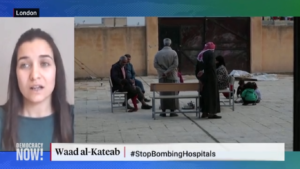
Syrian director Waad al-Kateab interviewed on Democracy Now, March 17, 2022
Assad and Putin’s Counter-Revolutionary Aggression
Over the past decade-plus, the combined forces of the Syrian, Russian, and Iranian States and affiliated paramilitaries have committed heinous crimes in pursuit of their counter-revolutionary goal of suppressing the popular Syrian uprising, which began in March 2011.
Due to their viciousness, both in Syria and Ukraine, Assad and Putin recall the historical figures Generals Sergei Bulgakov (?-1824) and Alexei Yermolov (1777-1861), butchers of the Caucasus, as well as the French General de Ségur (1780-1873). In his function as Napoleon Bonaparte’s underling during the Grand Armée’s invasion of Russia (1812), Comte de Ségur sought to rationalize the extermination of the Muscovites as a necessity for “civilization.”36 Moreover, Putin and Assad’s crimes recall the aggression of the “new high-velocity m[e]n,” Red Army Commander Lev Trotsky (1879-1940) and Soviet Marshal M. N. Tukhachevksy (1893-1937), who crushed the Kronstadt and Tambov Communes in 1921, using overwhelming and relentless force of rapid maneuver.37 After all, the Assad regime’s prison system—described by the former political prisoner Mustafa Khalifeh as a central aspect of Syria’s topology of violence—builds on the French colonialists’ imposition of their carceral system on the country a century ago, as well as on the Soviet Gulag, which was itself inspired by Tsarist military colonies. In fact, the one-party dictatorship which Bashar’s father Hafez al-Assad imposed in 1970 was modeled after the Stalinist regime, and today, ideological and political partisans of Ba’athism openly seek a “USSR 2.0.”
Moreover, Putin and Assad’s employment of mass-aerial bombardment of civilians follows from the Swiss-French imperialist Le Corbusier’s (1887-1965) macabre avowal of air power to “redesign” the Casbah, or citadel, of Algiers, together with the surrounding Old City.38 As well, these autocrats’ use of “vertical power” follows the grim model of the Luftwaffe’s destruction of the Basque town of Guernika in April 1937, within the context of the Spanish Civil War—not to mention US atrocities in World War II, or the Korean, Vietnam, and Iraq Wars. If the Russian incendiaries and arsonists who sought to thwart the Grand Armée’s capture of Moscow in 1812 anticipated the pétroleuses of the 1871 Paris Commune, who aimed at burning down buildings symbolizing France’s despotic past and “block[ing] the Versailles invaders with a barrier of flames,” the Syrian anarchist Omar Aziz (1949-2013) was surely right to emphasize that his revolutionary compatriots’ struggle against the Assad regime is “no less than [that of] the workers of the Paris Commune.”39
Conclusion: Justice for Syria and Ukraine
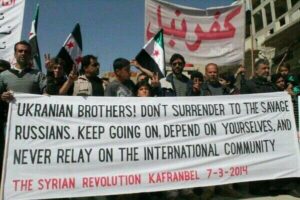
July 2014 banner from Syrian revolutionaries in Kafranbel in solidarity with Ukrainians under attack by Russia
As Munif and al-Kateab morosely chronicle, by all means, the Assad regime-axis has directed special retaliatory violence against autonomous and resistant communities, journalists, and medics in Syria.40 Healthcare workers who render aid to communities outside regime control risk being branded “enemies of the state,” and consequently being detained, tortured, and killed, in accordance with the regime’s strategy of “medical genocide.”41 The annihilatory tactics used by this regime and its allies—mimicking those employed by Western European imperialists, Nazis, and Stalinists alike—reproduce the “unconscious past” of the Soviet Gulag system, which inspired Ba’athist brutalism.42 In the same way, Assad and Putin’s brazen counter-revolution has arguably paved the way for not only the genocidal abuses being carried out by the Chinese Communist Party against millions of Uyghur, Kazakh, and Hui Muslims in Xinjiang, but also the Burmese junta’s coup of February 2021 and subsequent scorched-earth approach to dissent, as well as the ghastly ongoing attack on Ukraine.
Over six years into Russia’s military intervention to stabilize Bashar’s regime as Putin’s only client State in the “far abroad,” Russia has secured bases in the Eastern Mediterranean and destroyed regional Islamist groups by “turn[ing] the liberated areas into death zones.” Still, the pathos of children murdered by Assad and Putin’s bombs and shells in Syria and Ukraine is no less than that of Palestinian children murdered by the Israeli military.43 Echoing Israel’s tactics in Gaza, the Syrian and Russian air forces have targeted markets and up to fifty hospitals, as New York Times reporters have shown. In February 2021, seeking to market the lethality of its weaponry, the Russian military proudly released video of one of its Iskander ballistic missiles hitting Azaz National Hospital, north of Aleppo. On the Ukrainian front, as we have seen, the main enemy is the same.
In the continuities between the Tolstoyan scenes and sequences from the “Sevastopol Sketches” and War and Peace which center wounded and dying soldiers, the mass-displacement of civilians, and the urbicidal devastation of entire cities like Smolensk and Moscow during the Crimean and Napoleonic Wars on the one hand with the destruction of Syrian and Ukrainian cities like East Aleppo, Eastern Ghouta, Khan Sheikhoun, Mariupol, Kharkiv, and Kyiv on the other, we perceive constancy in the fundamentally brutal exercise of State power. We must face these tragedies with Tolstoyan realism and compassion by doing our best to stop Putin, Assad, and their enablers; avoiding an escalation from fratricidal to nuclear war; and supporting revolutionaries, protesters, refugees, and victims of militarism across borders.
1 Leo Tolstoy, Tolstoy’s Diaries, ed. and translated by R. F. Christian (London: Flamingo, 1985), 54.
2 Aylmer Maude, The Life of Tolstoy: Later Years (Oxford: Oxford University Press, 1987), 378.
3 Donna Tussing Orwin, “Chronology,” in The Cambridge Companion to Tolstoy, ed. Donna Tussing Orwin (Cambridge: Cambridge University Press, 2002), 4-6.
4 Rosamund Bartlett, Tolstoy: A Russian Life (New York: Houghton Mifflin, 2011), 246-9; Nicolas Berdyaev, Slavery and Freedom (San Rafael: Semantron Press, 2009), 66; Kenneth N. Waltz, Man, the State, and War: A Theoretical Analysis (New York: Columbia University Press, 2001), 101.
5 Leo Tolstoy, The Cossacks and Other Stories, trans. David McDuff and Paul Foote (London: Penguin Books, 2006), 192 (emphasis added).
6 John P. Clark, Between Earth and Empire: From the Necrocene to the Beloved Community (Oakland: PM Press, 2019), 194.
7 Алексей и Владимир Туниманов Зверев, Лев Толстой. Вступ. статья. В. Я. Курбатова (Moscow: Youth Guard, 2006), 12; Dmitry Shlapentokh, “Marx, the ‘Asiatic Mode of Production,’ and ‘Oriental Despotism’ as ‘True’ Socialism,” Comparative Sociology 18 (2019), 508; Richard Sokoloski, “Tolstoy’s The Death of Ivan Ilych: First and Final Chapter,” Tolstoy Studies Journal, vol. 9 (1997), 51; Peter Kropotkin, Russian Literature: Ideals and Realities (Montreal: Black Rose Books, 1991), 118.
8 Irvin D. Yalom, Existential Psychotherapy (New York: Basic Books, 1980), 478-80; James Hillman, A Terrible Love of War (New York: Penguin, 2004), 51.
9 Andrei Zorin, Critical Lives: Leo Tolstoy (London: Reaktion Books, 2020), 31; Liza Knapp, “The development of style and theme in Tolstoy,” The Cambridge Companion to Tolstoy, ed. Donna Tussing Orwin (Cambridge: Cambridge University Press, 2002), 172; Berdyaev 157; Gunisha Kaur, “From torture to ultraviolence: medical and legal implications,” The Lancet, 6 April 2021.
10 Anna Borshchevskaya, Putin’s War in Syria: Russian Foreign Policy and the Price of America’s Absence (London: I. B. Tauris, 2022), 42.
11 Yasser Munif, The Syrian Revolution: Between the Politics of Life and the Geopolitics of Death (London: Pluto, 2020), 37-40.
12 Lilie Chouliaraki, The Spectatorship of Suffering (London: Sage, 2006), 18, 76, 118.
13 Christopher Bellamy, “Tolstoy, Count Leo,” The Oxford Companion to Military History, ed. Richard Holmes (Oxford: Oxford University Press, 2001), 914; Orwin 4.
14 Serhii Plokhy, The Gates of Europe: A History of Ukraine (New York: Basic Books, 2015), 348; Catherine Evtuhov et al., A History of Russia: Peoples, Legends, Events, Forces (Boston: Houghton Mifflin, 2004), 399.
15 Zorin 26-7; Bartlett 109-11.
16 Knapp 171; Chouliaraki 21-43, 71 (emphasis in original); Charles Reitz, Ecology and Revolution: Herbert Marcuse and the Challenge of a New World System Today (Routledge: New York, 2019), 84-5.
17 Zorin 29; Evtuhov et al. 367-70; Christopher Bellamy, “Sevastopol, sieges of,” The Oxford Companion to Military History, ed. Richard Holmes (Oxford: Oxford University Press, 2001), 821.
18 Tolstoy 2006: 304, 187, 192.
19 Chouliaraki 38-9, 44-52, 85-93, 119-121, 124-48.
20 Tolstoy 2006: 190, 192, 200, 228-9 (emphasis in original).
21 Richard Stites, The Women’s Liberation Movement in Russia: Feminism, Nihilism, and Bolshevism, 1860-1930 (Princeton: Princeton University Press, 1990), 30-1.
22 Natasha McEnroe, “Celebrating Florence Nightingale’s bicentenary,” The Lancet, vol. 395, no. 10235, 2020), 1477.
23 Tolstoy 2006: 192, 196, 227-8).
24 Evtuhov et al. 370.
25 Tolstoy 2006: 204.
26 Rick McPeak, “Tolstoy and Clausewitz: The Duel as a Microcosm of War,” eds. Rick McPeak and Donna Tussing Orwin (Ithaca, New York: Cornell University Press, 2012), 116; Orlando Figes and Boris Kolonitskii, Interpreting the Russian Revolution: The Language and Symbols of 1917 (New Haven: Yale University Press, 1999), 148).
27 Chouliaraki 124; Hillman 49.
28 Tolstoy 2006: 221, 223-4, 227, 268-9.
29 Lisa Knapp, “The development of style and theme in Tolstoy,” The Cambridge Companion to Tolstoy, ed. Donna Tussing Orwin (Cambridge: Cambridge University Press, 2002), 170.
30 Tolstoy 2006: 236-7; Leo Tolstoy, War and Peace, trans. Louise and Aylmer Maude (Oxford: Oxford University Press, 2010), 756.
31 Tolstoy 2006: 247-8, 25; McPeak 115.
32 Tolstoy 2010: 27, 677.
33 Terry Eagleton, Reason, Faith, and Revolution: Reflections on the God Debate (New Haven: Yale University Press, 2009), 27, 168; Clark 187.
34 Samer Jabbour et al. “10 years of the Syrian conflict: a time to act and not merely to remember,” The Lancet, vol. 397, issue 10281 (2021), P1245-8.
35 Rania Abouzeid, No Turning Back: Life, Loss, and Hope in Wartime Syria (New York: W. W. Norton and Company, 2018), 182-3; Munif 9.
36 Alexander M. Martin. “Moscow in 1812: Myths and Realities.” Tolstoy On War, eds. Rick McPeak and Donna Tussing Orwin (Ithaca, New York: Cornell University Press, 2012), 42-58.
37 Richard Stites, Revolutionary Dreams: Utopian Vision and Experimental Life in the Russian Revolution (Oxford: Oxford University Press, 1989), 161; Christopher Bellamy, “Tukhachevskiy, Marshal Mikhail Nikolaeyich,” The Oxford Companion to Military History, ed. Richard Holmes (Oxford: Oxford University Press, 2001), 924-5; Neil Croll, “The role of M.N. Tukhachevskii in the suppression of the Kronstadt Rebellion,” Revolutionary Russia, (17) 2 (2004), 10-14.
38 Munif 43-6, 90.
39 Robert Graham, We Do Not Fear Anarchy; We Invoke It (Oakland: AK Press, 2015), 6-7; David A. Shafer, The Paris Commune: French Politics, Culture, and Society at the Crossroads of the Revolutionary Tradition and Revolutionary Socialism (New York: Palgrave Macmillan, 2005), 95, 159.
40 Munif 33-6.
41 Jabbour et al.
42 Nancy Chodorow, The Power of Feelings (New Haven: Yale University Press, 1999).
43 Borshchevskaya 169.


Leave a Reply